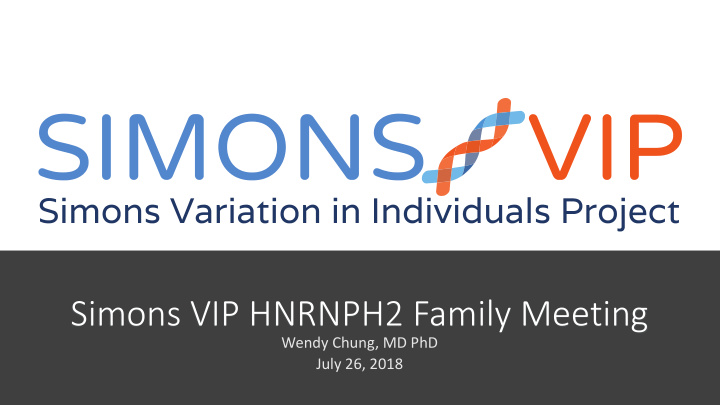



Simons VIP HNRNPH2 Family Meeting Wendy Chung, MD PhD July 26, 2018
Genetics • Caused by changes in the HNRNPH2 gene • All reported cases are de novo • Recurrence risk if ~1%
Our Genome 23 from Mom 23 from Dad
The gene HNRNPH2 • Gene called Heterogeneous nuclear ribonucleotide binding protein H2 ( HNRNPH2 ) • Gene makes protein called HNRNPH2 • Gene on the X chromosome January 15, 2017 HNRNPH2 Family Meeting
Genetic mutations in HNRNPH2 are de novo. When do de novo mutations occur? • In the egg • In the sperm • At or shortly after conception • No way to know • Recurrence risk of 1% in future pregnancies
Chromosomes in male and females Female Male January 15, 2017 HNRNPH2 Family Meeting
Simons VIP Individuals with HNRNPH2 Mutation • Total number of registered, consented, participating families, n = 10 • Total number of participants with medical history data, n = 9 • 9 female, 0 male • Ages 3 – 36 years
Variants in HNRNPH2 Mutations Observed (10 individuals) Protein Change Arg206Trp 9 Arg206Gln 1
Common Developmental and Behavioral Diagnoses Condition Number of Children Intellectual disability 5 Autism spectrum disorder 4 Developmental delay 4 Language or speech disorder or delay 4 (without intellectual disability) Anxiety 3 N = 9
Parent report of medical history (9 individuals, ages 3 – 36 years)
Newborn Issues Medical Condition Number of Children Lethargic 5 Poor suck 4 Feeding difficulties 4 Breathing difficulties 2 Resuscitation 1 Problems with tone 3
Hearing and Vision Condition Number of Children Strabismus (cross eyed) 5 Vision correction 4 Nearsighted 4 Astigmatism (imperfect eye curvature) 1 Depth perception 1 Hearing aids 1
Neurological Issues Medical Condition Number of Children Low muscle tone 9 Movement abnormalities 4 Microcephaly (head smaller than 3 average) Clumsy 2 High muscle tone 1
Neurological Issues Medical Condition Number of Children Seizures 2 Grand mal 2 Petit mal 1
Gastrointestinal Issues Medical Condition Number of Children Reflux (heartburn) 1
Endocrine Issues Medical Condition Number of Children Difficulty gaining weight 4 Short stature 2
Bone Issues Medical Condition Number of Children Scoliosis (curved spine) 2 Mild kyphosis (rounding of back) 1
Surgeries Medical Condition Number of Children Surgery to correct foot positioning 1 Tendon release 1 Scoliosis repair 1 Ear tubes 1 Dental surgery 1 Hip dysplasia 1 Broken clavicle repair 1 Feeding tube 1
Current Medication Use (SVIP Medications Interview, 9 individuals) Conditions Number of Children Behavior (including anxiety, antidepressants, sedatives, 4 antipsychotics) Gastrointestinal 3 Seizures 1
Milestones Milestone Average age for walking (4 individuals) 4.3 years Age range for walking 2.75 – >7 years Average age for first words (4 individuals) 19 months Age range for first words 12 months – 25 months Average age bladder & bowel trained (2 individuals) >7 years Age range for bladder or bowel training >7 years
Summary-mostly neurological symptoms • Developmental delay or intellectual impairment • Language delays • Motor delays • Hypotonia • Autism/autistic behaviors • No regression
Recommend
More recommend